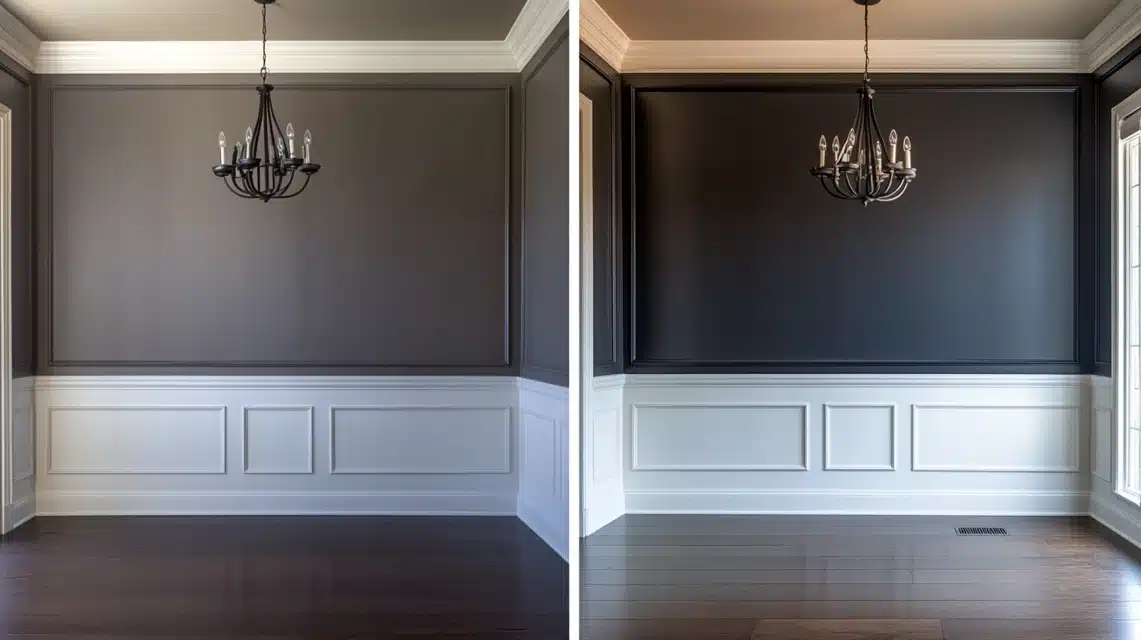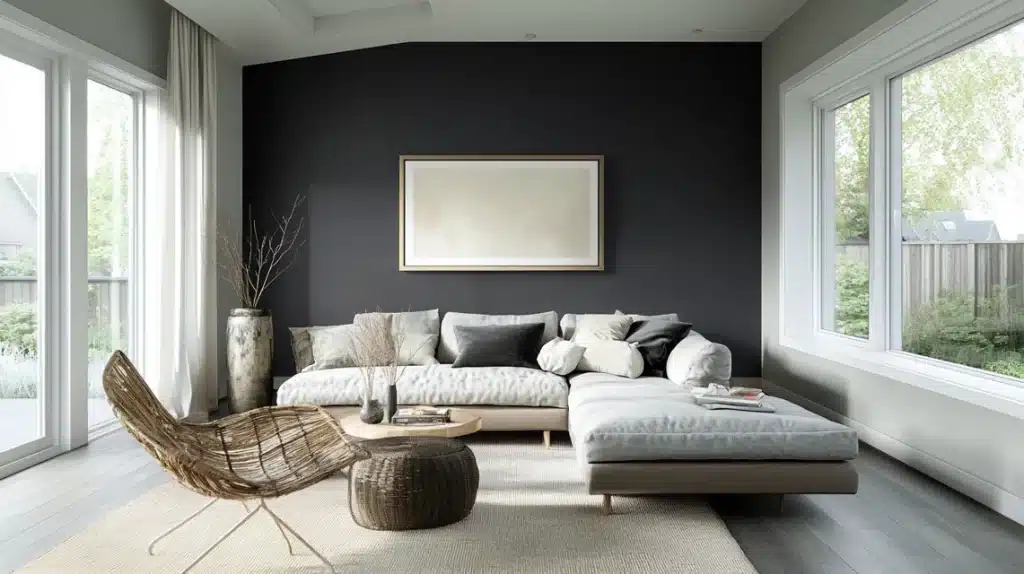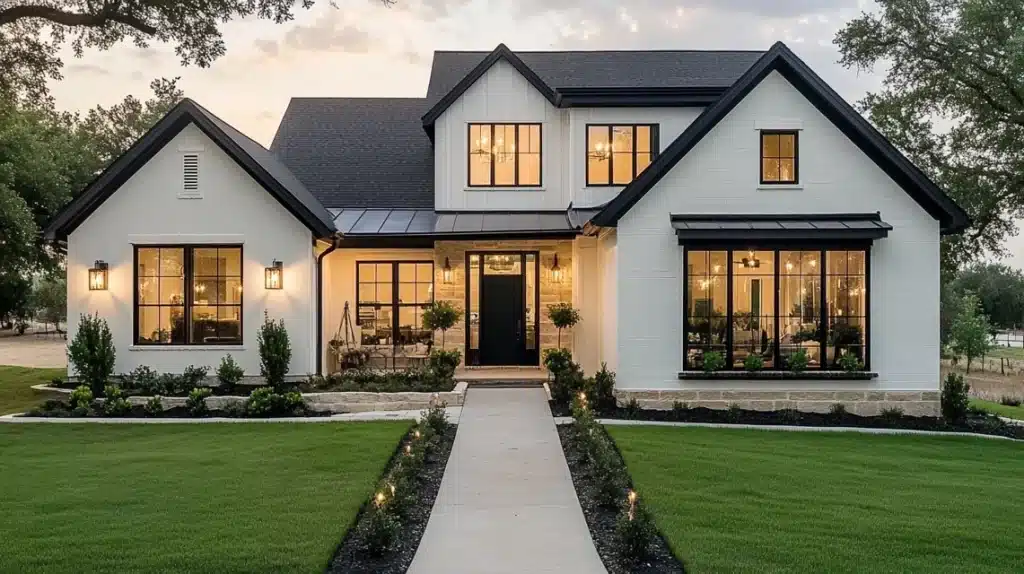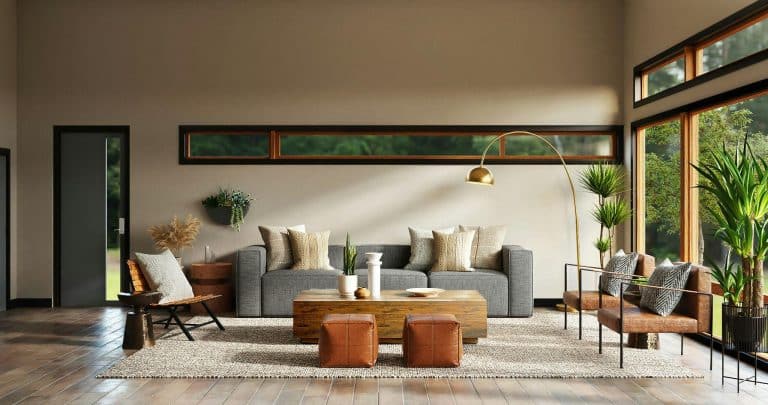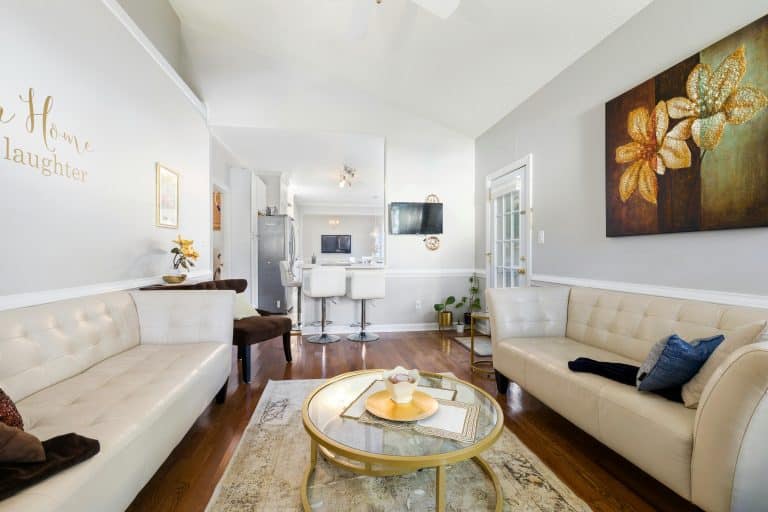Sherwin Williams Peppercorn vs Iron Ore
When clients ask me about dark paint colors, two names keep coming up: Sherwin Williams Peppercorn and Iron Ore.
As someone who’s tested these colors in hundreds of spaces, I know firsthand how tricky the decision can be.
At first glance, they might look like simple dark grays, but there’s nothing simple about them.
Through years of real-world testing, let me share what I’ve discovered about these sophisticated dark shades.
Understanding the Basics of Sherwin-Williams Peppercorn
What is Peppercorn?
Sherwin Williams Peppercorn offers a rich, dark charcoal gray that many mistake for black at first glance.
Peppercorn brings more depth than a simple dark gray – it shows different faces depending on your space. While some see it as a pure gray, its undertones tell a more complex story.
The color shifts between subtle hints of purple, occasional blue touches, and rare green glimpses, particularly in outdoor settings.
LRV (Light Reflectance Value) of Peppercorn
With an LRV of 10, Peppercorn sits right at the threshold of dark colors without falling into true black territory.
On a scale where 0 is black, and 100 is white, this rating means it keeps some visibility even in lower light.
Peppercorn maintains its character and depth, unlike darker paints that can look flat black in dim spaces.
Even in rooms with minimal lighting, it shows a gentle softness rather than appearing stark or harsh.
Key Characteristics of Peppercorn
What Makes Peppercorn Stand Out:
- Favors purple undertones but stays flexible
- It shows blue notes in certain lights
- It can hint at green, especially outdoors
- Maintains its depth without looking flat
- Works with bright whites for contrast
Best Pairings:
- Pure White trim creates clean lines
- High Reflective White offers a sharp contrast
- Cool-toned furnishings complement its nature
The Color Performs Differently Across Spaces:
- Indoor walls show its purple-blue side
- Exterior applications might reveal green notes
- Well-lit areas display their full character
- Dim spaces keep its soft charcoal quality
Understanding the Basics of Sherwin-Williams Iron Ore
What is Iron Ore?
Sherwin Williams Iron Ore distinguishes soft black and deep charcoal gray. While many initially see it as pure black, this color offers more subtlety.
Think of it as an “off-black” – similar to how off-white softens pure white, Iron Ore softens true black.
Its undertones shift between gentle hints of green and touches of navy blue, depending on your lighting and space.
LRV (Light Reflectance Value) of Iron Ore
At an LRV of 6, Iron Ore sits firmly in the dark range. For context, pure black ranks at 0 and pure white at 100, placing Iron Ore close to true black without fully committing to that intensity.
It can look nearly black in rooms with limited light, but it keeps its soft charcoal quality in well-lit spaces, avoiding the stark feel of pure black.
Key Characteristics of Iron Ore
Standout Traits:
- Works with both warm and cool color schemes
- Changes subtly throughout the day
- It keeps its depth without looking harsh
- Shows its true charcoal nature in bright light
Best Uses:
- Kitchen cabinets and islands
- Front doors and window frames
- Accent walls in spacious rooms
- Built-in shelving units
- Bathroom Vanities
Important Tips:
- Limit use to 3-4 areas per home
- It needs good lighting to show its character
- Works best in rooms with ample space
- Pairs well with both warm and cool whites
Comparison Table: Peppercorn vs. Iron Ore
| Feature | Sherwin-Williams Peppercorn | Sherwin-Williams Iron Ore |
|---|---|---|
| Color Family | Dark charcoal gray with subtle softness | Deep charcoal gray, nearing black |
| LRV (Light Reflectance Value) | 10: Holds a soft look even in low light | 6: Appears closer to black, especially in dim spaces |
| Undertones | Purple, blue, or green, depending on lighting | Green or navy blue, adaptable to warm or cool tones |
| Ideal Lighting | Best with adequate lighting; can soften in dim spaces | It needs ample natural light to avoid looking too dark |
| Room Suitability and Popular Uses | Accent walls, cabinetry, kitchen islands, or bedroom features | Entryway doors, window trims, bathroom vanities, or exterior statements |
| Undertones and Pairings: What to Consider | It pairs well with cool whites like Sherwin-Williams Pure White or High Reflective White; it complements blues and grays. | It pairs beautifully with creamy whites like Alabaster or Greek Villa and complements warm woods and cool stones. |
| Challenges | Undertones can shift unpredictably in certain lights | It may feel too bold for smaller, dimly lit spaces |
| Popular Appeal | Flexible and versatile for cool-toned palettes | Timeless and dramatic for bold design statements |
Testing Colors: Why it Matters
Proper testing becomes even more critical when dealing with dark paint colors like Peppercorn and Iron Ore. Here’s my experience-based guide to making the right choice.
Natural Light Matters Most
Different light exposures create different effects.
South-Facing Rooms:
- Iron Ore might show more of its green tones
- Peppercorn’s purple notes become clearer
- Both colors stay true to their depth
North-Facing Rooms:
- Iron Ore displays its neutral side
- Peppercorn leans toward its blue tones
- Both colors appear slightly cooler
Time of Day Changes Everything
Watch how the colors shift.
- Morning: Shows true color qualities
- Midday: Brings out undertones
- Evening: Colors appear deeper
- Artificial light: Can change how dark they look
Smart Testing Methods
Follow these steps for better results.
- Paint large squares (at least 12×12 inches)
- Place samples on multiple walls
- Check near windows and corners
- Look at them next to your trim color
- Test beside furniture and flooring
- Use peel-and-stick samples to move around
Compare and Contrast
Test both colors together.
- Place samples side by side
- Check them at different times
- Look at them under your usual lighting
- Compare against your existing features
- Take photos to spot undertones
Remember: Dark colors need more testing than light ones. What looks like a slight difference on a small sample can become dramatic on your walls. Take at least 24 hours to observe before making your choice.
Summing Up
What matters most is that your space, lighting, and comfort level with dark colors should guide your choice.
Having used Peppercorn and Iron Ore in countless homes, I can tell you there’s no “better” option – just the right one for your needs.
If you want a softer, more changeable look, consider Peppercorn. If you’re after that deep, steady presence, Iron Ore might be your answer.
Take your time with samples, trust your eyes, and remember – these colors will look different in your space than in anyone else’s home.
Frequently Asked Questions
Which Color is Better for Exteriors, Iron Ore or Peppercorn?
Iron Ore works better outside; its deeper tone creates stronger curb appeal. Peppercorn, especially its green notes, can show more undertone shifts outdoors, making it less predictable.
What are the Pros and Cons of Using Dark Paint Colors?
Pros: Create strong statements, hide wall flaws, and add sophistication.
Cons: Show dirt easily, make rooms feel smaller, need excellent lighting, and require more coats during painting.
What is the Difference Between Iron Ore and Peppercorn?
Iron Ore (LRV 6) is darker and more neutral, perfect for bold statements. Peppercorn (LRV 10) is lighter with more visible undertones, offering a softer, more variable look.

